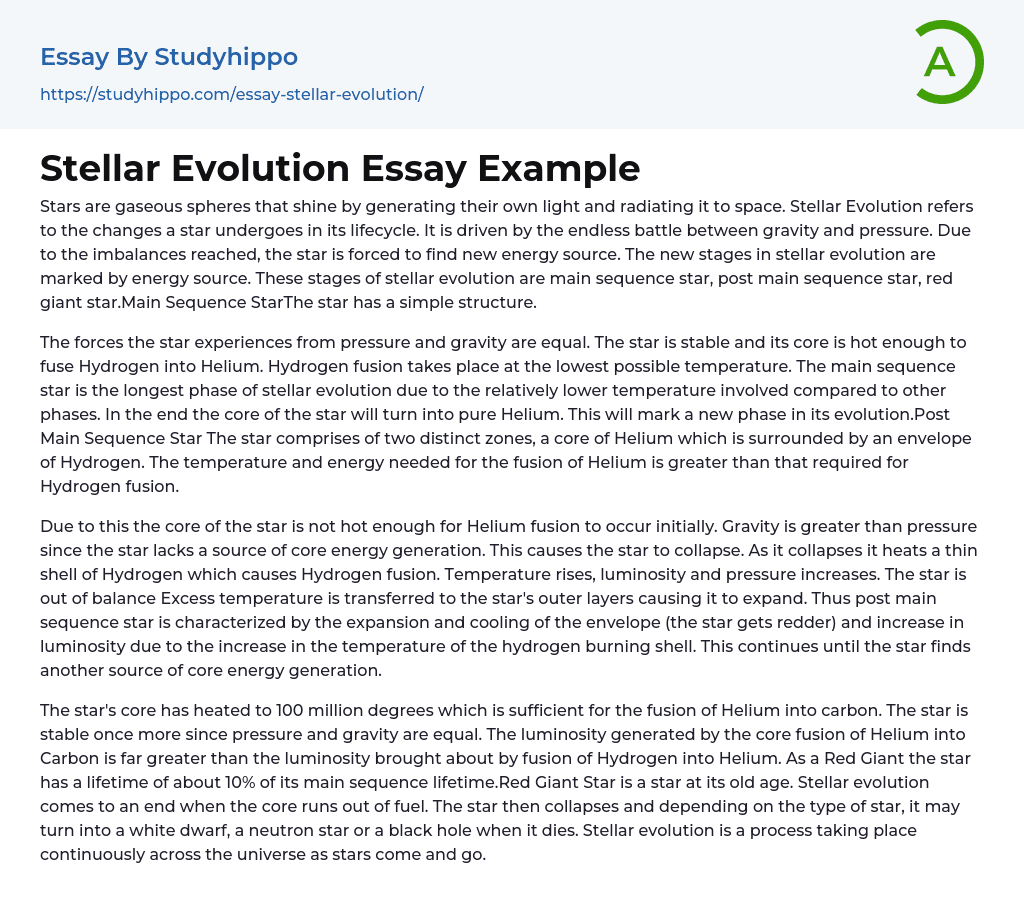Stars are gaseous spheres that shine by generating their own light and radiating it to space. Stellar Evolution refers to the changes a star undergoes in its lifecycle. It is driven by the endless battle between gravity and pressure. Due to the imbalances reached, the star is forced to find new energy source. The new stages in stellar evolution are marked by energy source. These stages of stellar evolution are main sequence star, post main sequence star, red giant star.Main Sequence StarThe star has a simple structure.
The forces the star experiences from pressure and gravity are equal. The star is stable and its core is hot enough to fuse Hydrogen into Helium. Hydrogen fusion takes place at the lowest possible temperature. The main sequence star is the longest phase of stellar evolution due to the r
...elatively lower temperature involved compared to other phases. In the end the core of the star will turn into pure Helium. This will mark a new phase in its evolution.Post Main Sequence Star The star comprises of two distinct zones, a core of Helium which is surrounded by an envelope of Hydrogen. The temperature and energy needed for the fusion of Helium is greater than that required for Hydrogen fusion.
Due to this the core of the star is not hot enough for Helium fusion to occur initially. Gravity is greater than pressure since the star lacks a source of core energy generation. This causes the star to collapse. As it collapses it heats a thin shell of Hydrogen which causes Hydrogen fusion. Temperature rises, luminosity and pressure increases. The star is out of balance Excess temperature is transferre
to the star's outer layers causing it to expand. Thus post main sequence star is characterized by the expansion and cooling of the envelope (the star gets redder) and increase in luminosity due to the increase in the temperature of the hydrogen burning shell. This continues until the star finds another source of core energy generation.
The star's core has heated to 100 million degrees which is sufficient for the fusion of Helium into carbon. The star is stable once more since pressure and gravity are equal. The luminosity generated by the core fusion of Helium into Carbon is far greater than the luminosity brought about by fusion of Hydrogen into Helium. As a Red Giant the star has a lifetime of about 10% of its main sequence lifetime.Red Giant Star is a star at its old age. Stellar evolution comes to an end when the core runs out of fuel. The star then collapses and depending on the type of star, it may turn into a white dwarf, a neutron star or a black hole when it dies. Stellar evolution is a process taking place continuously across the universe as stars come and go.
- Oxygen essays
- Atmosphere essays
- Coral Reef essays
- Desert essays
- Earth essays
- Ocean essays
- Lake essays
- Sea essays
- Biodiversity essays
- Natural Environment essays
- Forest essays
- Soil essays
- Water essays
- Rainbow essays
- Ecosystem essays
- Volcano essays
- Wind essays
- Forestry essays
- Bottled Water essays
- Energy essays
- Density essays
- Thermodynamics essays
- Motion essays
- Atom essays
- Sound essays
- Electricity essays
- Nuclear Power essays
- Temperature essays
- Physiology essays
- Light essays
- Force essays
- Heat essays
- Speed essays
- Big Bang Theory essays
- Energy Development essays
- The elements essays
- Voltage essays
- Solar Energy essays
- Nuclear Energy essays
- Alternative Energy essays
- Melting essays
- Nuclear Family essays
- Agriculture essays
- Albert einstein essays
- Animals essays
- Archaeology essays
- Bear essays
- Biology essays
- Birds essays
- Butterfly essays




